 |
BSA
WD M20 Electrical Equipment |
|
| Created with the kind help of Steve
Madden,
Co-Author,
British Forces Motorcycles 1925 - 1945.
|
| |
|
Click on the
pictures to enlarge! |
|
Electrical Horns |
|
The civilian
1940 BSA parts list states that a Lucas Electric Horn type 700771 was
fitted to the M20. According to the Lucas parts book this is a Lucas HF1140.
The 1940
Military BSA parts list states a Lucas Electric Horn type 701717 for the
M20, no further information about this model horn yet. More information about
WD Electric Horns is very welcome.
|
| |

|
|
Here a
factory picture of a 1939 KM20 with MT1130 1940 model taillight fitted
which should be fitted with a HF1140 according to the parts book.
|
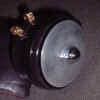
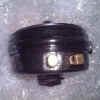
|
|
Lucas HF1140
as used on the 1940 model M20.
|

|
|
This is a
factory picture that shows a bike with frame number WM20 30775 what
makes it a 1941 motorcycle.
|
| |

|
|
This is a
factory picture that shows a bike with frame number WM20 52778 what
makes it a 1942 motorcycle.
|
|




|
|
Lucas Electric Horn type
HF1141 dated 8-42.
|
|
|

|
|
This is a
picture that shows a bike with frame number WM20 79556 what makes it a
1942 motorcycle fitted with a HF1235 horn. It seems
that during 1942 they changed from the Lucas HF1141 to the Lucas
HF1235 horn.
|
|
|



|
|
Lucas Electric Horn type
HF1235 dated 9-43.
|
|
|



 |
|
These
pictures shows a HF1235 horn, this horn is
dated 1-44. There are two Lucas HF1235 WD Body casting patterns, one
with a flush adjuster screw head one with a recess adjuster screw head.
The one with the flush adjuster head has been continued as civilian post
ww2 pattern while the one with the recess pattern became introduced
again for the 1951/2 HF1235 pattern. |
|
|
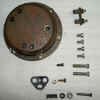

 |
|
These
pictures shows a HF1235 horn being rebuild by Boudewijn. This horn is
dated 10-44. |
|
|

|
|
This is a
factory picture that shows a bike with frame number WM20 116xxx what
makes it a 1945 motorcycle which seems to be fitted with a Lucas HF1235
horn. |
|
|
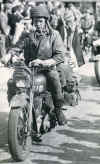
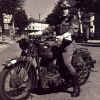

 |
|
These four
pictures appear to have the same horn which are probably Clearhooters. |
|
|


|
|
Clearhooter
HF180 (removed from a 1941 Enfield WD/C)
|
|
|
|
|
|
Headlight |
|
|

|
|
LUCAS 8" Size Panel Headlight TYPE DU 142,
used on BSA WD M20 up to late-1941/early 42. |
|
|

|
|
LUCAS 6" Size Panel Headlight TYPE DU
42, used on
BSA WD M20 from early-1942. |
|
|
|
Ammeter |
|
|


|
|
Lucas CZ27
ammeter. |
|
|
|
The standard ammeter fitted throughout the war years to all machines was a Lucas TYPE CZ 27. Late-war produced machines (late-44/early 45) dispensed with the ammeter and had a different light-switch fitted.
The CZ 27 ammeter was not specific to WD-use and was introduced during the 1930's for civilian machines and continued in service after the war through to the 1950's. These ammeters are very robust, however, they are also extremely difficult to find today. |
|
|
|
Light switch |
|
|


|
|
War time switches.
|
|
|
|
The standard light switch
fitted throughout the war years was a Lucas 4-position switch, the additional position being a "T" for "tail-light". This position was used for convoy duties and would illuminate the rear-lamp only. Late-war produced machines employed a different 4-position
switch in conjunction with the removal of the ammeter. This later pattern of switch did not last long and the common earlier type of 4-position WD switch continued in use on WD -machines through to the 1960's.
|
|
|
|
Late-war switches were Little seen and used, this switch looks identical to the common switch but has different positions, these being "Test, Off, L, H" (for "test, off, low beam and high beam"). This switch was mounted in a steel rectangular plate with a pointed lower-end, usually on a strip-bracket affixed below the bike's saddle and extending off the right-side saddle spring mounting bracket. The open rear of the switch was then covered by a large domed black bakelite detachable cover. The ammeter was no longer fitted to the machine, the panel on the headlight having a blank, uncut area where the ammeter would have normally been. In place of the
light switch was fitted a large black bakelite "push" button, marked on top "P" (for "push"). On pushing this button the rider changed from main beam to low beam, and vice-versa). With the ammeter missing, the idea of this system to see if the dynamo was charging was to turn the switch to the "test" position and to rev-up the bike's engine. If, on doing this, the tail-light bulb was seen to glow brightly, then the system was seen to be
charging. |
|
|

 |
|
Late-war switch and push button. |
|
|
|
Black-out
masks |
|
|
|
The common WD-type of blackout mask was not introduced until late-1941, both 8" and 6" sizes. Prior to this, all WD bikes were fitted with a thin-card shield within the headlight. This was officially termed "Mask, Black
Manilla" (manilla being the type of thin card used). This early mask was simply a simple circle of thin black card cut to the appropriate size with the centre bearing a half-circle cut-out (to show on the lower portion) to emit light from. It was fitted BEHIND the headlight glass, in front of the reflector. To assist the restricted lighting, the lower-half of the
headlight reflector was supposed to be painted black too, to divert reflections
downwards. |
|
|
 |
|
Painted
lower-half of the reflector. |
|
|
|
There are several patterns of hooded blackout shield, not all made by Lucas....many other firms produced them too. They do not all have a second (lower) apperture for the low-beam or pilot-light, and if they do, the hole can be very, very small on certain early examples......the hooded masks were generally finished in flat black paint by the manufacturer, ranging from a dead matt shade through to a semi-gloss black.....some bear the manufacturers markings.....ALL types of blackout mask were fitted by the manufacturer at the factory. Indeed, in most cases, they are listed within the bike's parts
list. |
|
|


|
|
8"and
6"blackout masks.
|
|
|
|
Lucas
L WD MCT1 WD-pattern tail-light |
| |
| On
the early military models certain "pre-war" features were
fitted such as the Lucas MT110 tail-light and the scarce 1940 Lucas
MT1130 streamlined
"art-deco" style tail-light. |
|
 |
| Lucas
MT110 taillight. |
| |
 |
| Lucas
MT110 taillight. |
| |
 |
| Lucas
MT1130 taillight |
| |
 |
| Lucas
MT1130 taillight. |
| |
| Civilian
model taillights as used before the standard WD-pattern tail-light
was introduced. |
| |
| There
are two main versions of the Lucas WD-pattern tail-light. The first pattern, introduced in
late-1940/early-1941, is distinctive in that it has a black rubber
seal permanently fixed beneath the bulb-holder and lens-cover
mounting using the securing rivets. The cover then extends outwards
to cover the join between the lens cover and the cover mounting,
providing a waterproof seal. This type of tail lamp was discontinued
by 1943 and a modified pattern introduced which was identical but
lacking the rubber seal. This was due to rubber shortages. This
later lamp is the one commonly encountered today. |
|
|
 |
|
Fag-end
taillight, missing it's waterproof seal. |
|
|
|
There
were 3 distinctive types of lens cover for the two types of lamp. The
initial model with the tiny rear-lens. This was soon nicknamed the
"fag-end" tail light as the light emitted was considered the
same as the end of a burning cigarette ! This light was a reminder of
the severe blackout regulations in force at the time of it's
introduction. These lenses were used in conjunction with the
first-pattern lamp. In 1942/43 a second pattern lens cover was
introduced, identical to the previous model but with a larger red-lens
that did not provide excessive glare. This lens was fitted to both the first
and second pattern lamps. In 1944/45 a third pattern lens cover was
introduced, identical to the second pattern but with a rectangular
covered aperture cut into the lower-part of the cover-body to provide
illumination to the rear mudguard and numberplate (if fitted). This
later cover was introduced due to a relaxation in blackout regulations
and to assist with convoy marshalling and recognition. Some of these
later covers are marked on the top "MT3" (the class of stores
from which the lens cover is catalogued). |
|
|





|
|
First
pattern taillight with waterproof seal with second pattern lens. |
|
|
|
The
first model lamp is marked on the reverse of the body with "Joseph
Lucas Ltd, Birmingham". The second model is usually lacking this,
but has stamped onto the lower-front of the body "L WD MCT1".
Those lamps produced from 1944/45 onwards are normally marked "L WD
MCT1A", the "A" referring to "aperture" in
conjunction with the third pattern lens cover by then usually
supplied with the lamp. |
|
|

|
|
Second
pattern taillight dated October 1943. |
|
|
|
The 2nd
pattern lamp, marked "A", is commonly found today together
with the third pattern cover. Many are brand-new and still in boxes,
having sat unused in stores. The WD-tail light did not last in service
longer than a couple of years after the war, as rear number plates and
improved civilian-pattern lighting reappeared on military bikes. The
first-pattern rear light is very hard to find today, as most were used
up. The second pattern lens cover still turns up at autojumbles but
the first pattern cover is very difficult to locate. |
|
|

|
|
Second
pattern taillight new in it's box.
|
|
|
|
Dynamo
re-polarization
|
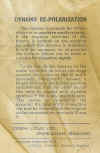
|
|
|
|
|